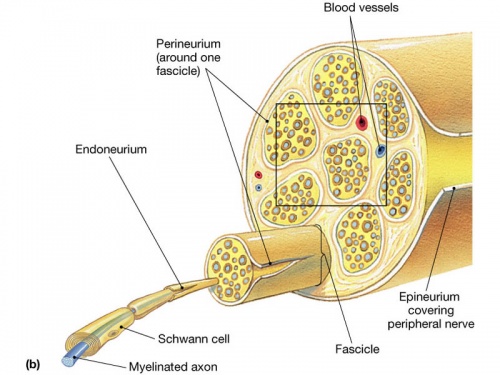Classification of Peripheral Nerve Injury
Original Editor - Tomer Yona
Top Contributors - Tomer Yona, Emma Sewell, Jayati Mehta, Kaylee Byars, Katherine Baca, Kim Jackson, Naomi O'Reilly, Claire Knott, Lucinda hampton and Matt Huey
Description[edit | edit source]
There are three basic types of peripheral nerve injuries (PNI) commonly seen in the clinic[1].
- Stretch related- the peripheral nerves are elastic, but when a traction force is too strong injury occurs. If the Traction force is strong enough, a complete tear may occur, but most commonly the continuity is retained, resulting in injuries such as Erb's Palsy.
- Lacerations-Another common type of PNI are lacerations created by blades. those types of injuries might be complete transections- but most commonly some continuity remains.
- Compressions-The third type of PNI are compression These injuries include the Saturday Night palsy due to radial nerve compression as well as entrapment neuropathies and do not involve tearing of the neural elements[1].
The most common of the three is stretch-related, followed by lacerations and compression[2].
Classification[edit | edit source]
There are two commonly used classification for PNI- the Seddon classification and the Sunderland classification.
Seddon classified nerve injuries into three major groups: neurapraxia,axonotmesis, and neurotmesis whereas Sunderland expanded Seddon's classification to five degrees of peripheral nerve injury as described in the table below: [2] [3]
| Seddon | Process | Sunderland |
| Neurapraxia | Local myelin damage usually secondary to compression | First degree |
| Axonotmesis | Axon severed but endoneurium intact (optimal circumstances for regeneration) | Second degree |
| Axonotmesis | Axon discontinuity, endoneurial tube discontinuity, perineurium and fascicular arrangement preserved | Third degree |
| Axonotmesis | Loss of continuity of axons, endoneurial tubes, perineurium and fasciculi; epineurium intact | Fourth degree |
| Neurotmesis | Complete physiologic disruption of entire nerve trunk | Fifth degree |
Nerve Anatomy[edit | edit source]
For a great information source for Physiotherapy following nerve injury see Nerve Injury Rehabilitation Physiotherapy
Resources[edit | edit source]
- http://www.gms-books.de/node/638
- http://www.scielo.br/scielo.php?script=sci_arttext&pid=S0004-282X2013001100811
References[edit | edit source]
- ↑ 1.0 1.1 Burnett MG, Zager EL. Pathophysiology of peripheral nerve injury: a brief review. Neurosurgical focus. 2004 May;16(5):1-7.
- ↑ 2.0 2.1 Campbell WW. Evaluation and management of peripheral nerve injury. Clinical neurophysiology. 2008 Sep 30;119(9):1951-65.
- ↑ Lee SK, Wolfe SW. Peripheral nerve injury and repair. Journal of the American Academy of Orthopaedic Surgeons. 2000 Jul 1;8(4):243-52.
- ↑ http://www.gms-books.de/book/living-textbook-hand-surgery/chapter/nerve-injury-classification-clinical-assessment
- ↑ nerve damage and regeneration








